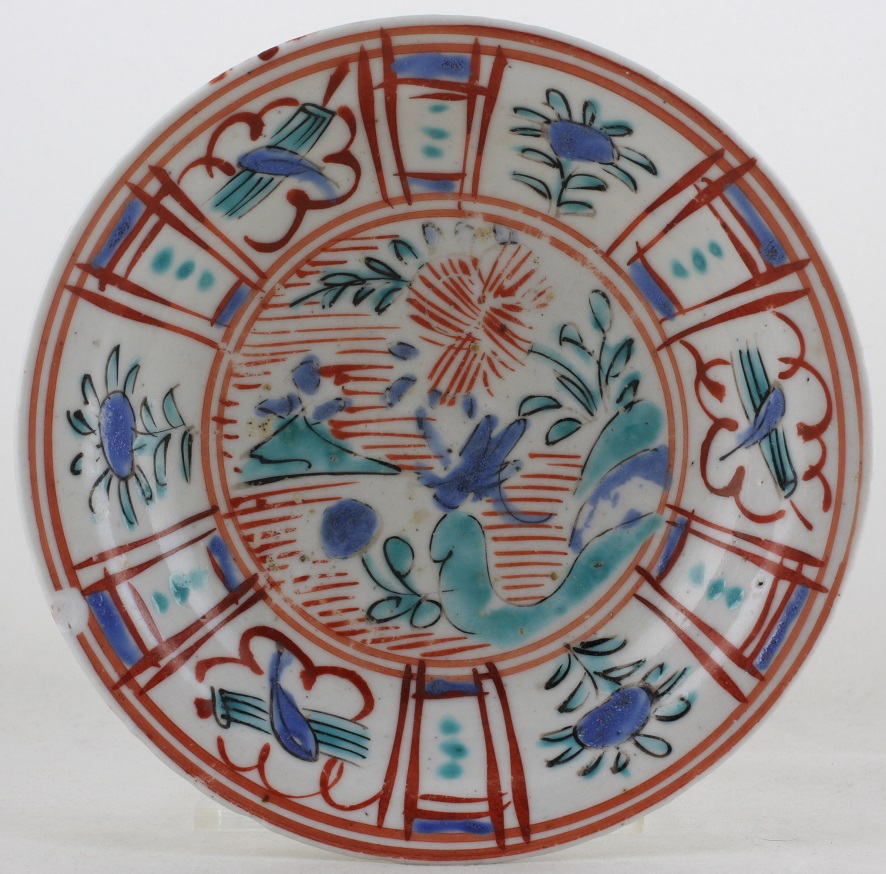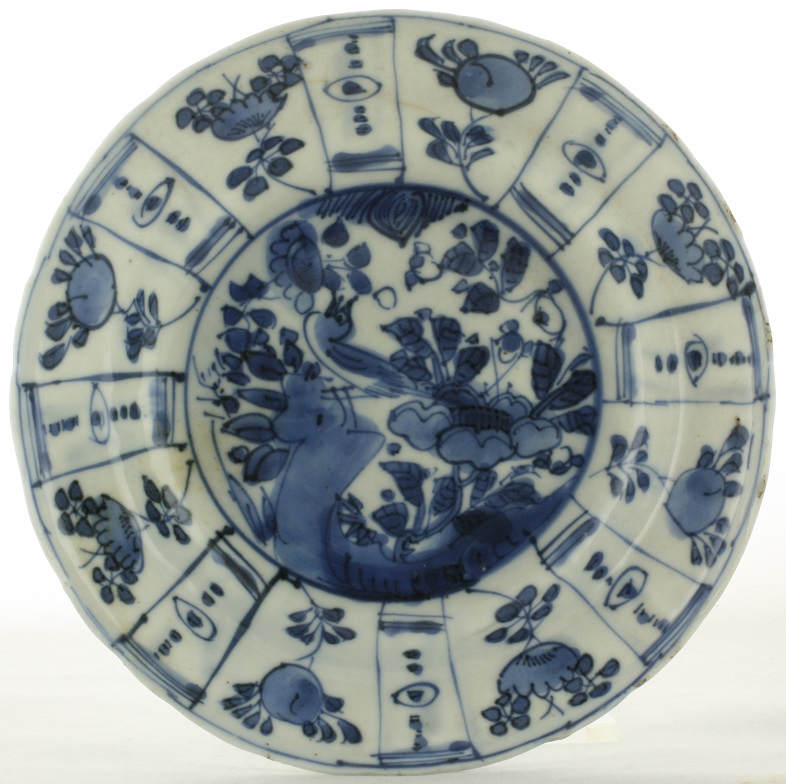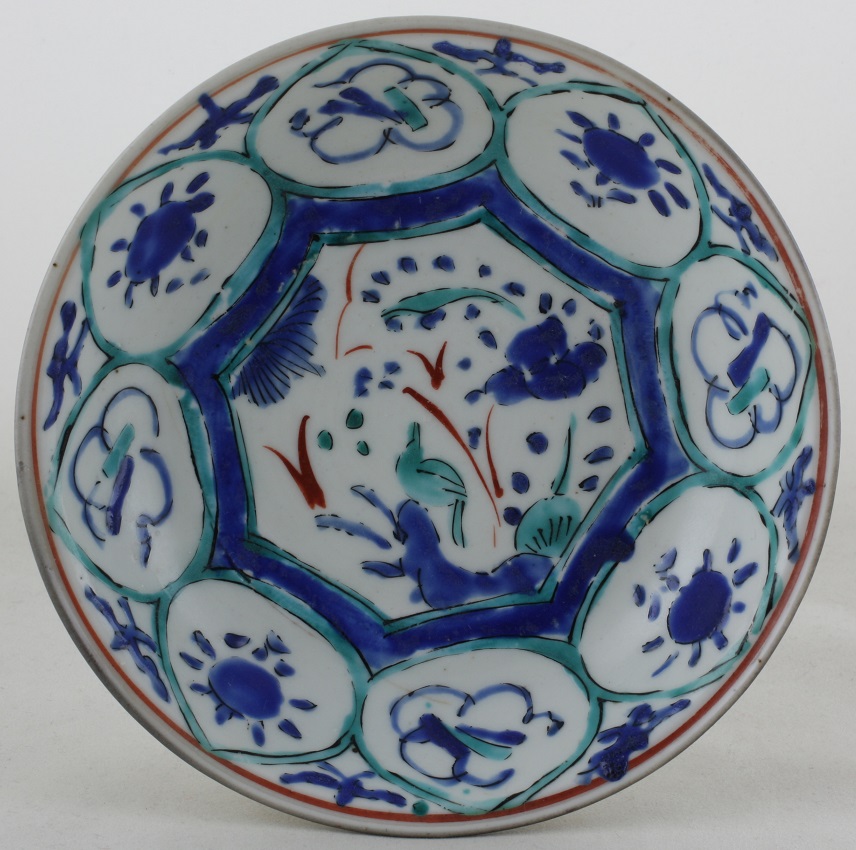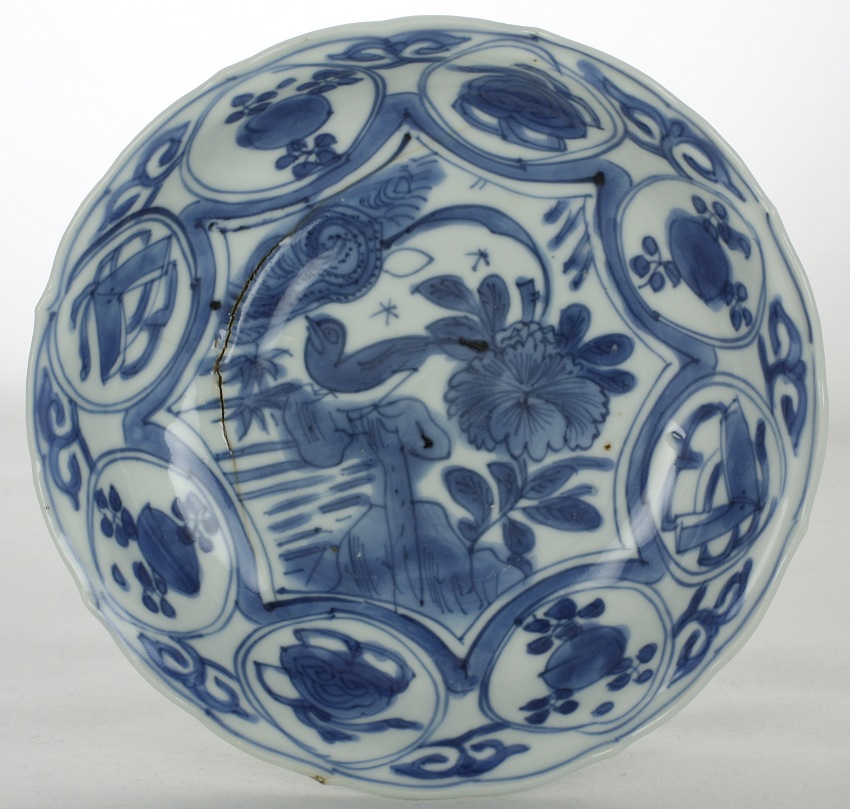Sold Ceramics
Sold Japanese Early Overglaze Enamelled wares 1660-1680
Page 1
Japanese documents, kiln-site excavations and surviving pieces seem to confirm that Arita potters started making porcelain with an enamelled decoration in the mid-1640's. Influences of Chinese polychrome porcelain are obvious. Chinese wares had been imported into Japan in some quantity and found a ready market. It is understandable that Japanese potters tried to copy them in order to compete locally. Furthermore, in the mid-1640's, the Japanese must have faced the same problems as the Dutch: Chinese porcelain was no longer easily available due to the civil wars, and the desire for alternatives stimulated production in Arita. Producing polychrome wares required mastering new techniques. Instead of the single firing used for underglaze blue wares, pieces now had to be fired a second time at a lower temperature. It seems that Chinese potters provided the Japanese with the knowledge of decorating in enamels, technically so different from painting in underglaze blue or iron-oxide.
Initially, the Arita potters did not produce for export, but things changed when the Dutch started to buy porcelain in Japan, first privately in the mid-1650's or even earlier, and from 1657 formally through the Dutch East India Company, (Vereenigde Oost-Indische Compagnie, VOC) as well. In their letter of 12 July of that year, the Directors in Amsterdam asked Deshima to send samples of porcelain made in Japan, 'two or three pieces of each kind, to wit, those that are painted with all kinds of colours, blue and otherwise....' Accordingly, the first cargo of Japanese wares the VOC shipped to the Netherlands included many polychrome wares as try-outs, and must have found keen buyers as further shipments for patria contained assortments of enamelled wares as well as underglaze blue porcelain. (Jörg 2003/1, pp.49-51)
This group of enamelled export porcelain was coined 'early enamelled ware' by Impey because of the way their colour schemes and decorations) differed from the later Kakiemon and Imari wares that developed out of this group. They only cover a short period, from 1660 to 1680, and represent the 'early' phase of polychrome ware for export. The enamels are bright and show a strong green, a brownish yellow. a beautiful dark brick-red, a light aubergine and a surprising overglaze blue; outlines are mostly in black. Initially, the enamels were still rather opaque, but they became more transparent in time. The overglaze blue enamel is particularly interesting: it was used occasionally in China on Wanli pieces, but it was not until the end of the 17th century that it became popular on Kangxi famille verte pieces. (Jörg 2003/1, pp.49-51)
Ohashi states that the 'overglaze enamel technique was transferred to Japan from China'. Consequently he says, to enable the second firing, enamelled pieces had a wider footring than underglaze blue shoki-Imari pieces. However, saggars were not yet in use and both body and glaze usually show impurities. Pieces show combinations of enamels with underglaze blue or enamels only. Decorations were initially based on Chinese models, but quickly developed into a Japanese style. (Jörg 2003/1, p.51)
On the early enamelled wares. underglaze blue patterns are confined to circular lines around the foot, shoulder or neck or to a minor part of the composition, thus leaving the enamel painter much freedom. Some pieces do share characteristic elements, for instance, several jars, bottles and ewers show a ground of groups of parallel vertical short lines in a brick-coloured iron-red, indicating water. This device resembles comparable grounds on Chinese Transitional pieces decorated in wucai enamels, from which the idea may have been derived. It is not seen on later Kakiemon or Imari porcelain. (Jörg 2003/1, p.50)
Returning to the early enamelled wares, a special group has to be mentioned. It consists of plates, deep saucers and dishes with an enamelled decoration in kraak style. They closely follow the composition of underglaze blue Chinese models of kraak porcelain with a border of wide and narrow panels and a flowerpot or a river scene with birds in the centre. However they are only painted in overglaze enamels without any underglaze blue. These bright pieces must have been a most attractive replacement for Chinese kraak ware, which had become unavailable, and one would have expected the Dutch to have shipped them to The Netherlands in large quantities. This seems not to have been the case, however, as nearly all the pieces in Dutch collections have an Indonesian provenance. In general, early enamelled wares are noticeably lacking in Dutch museums when compared to more substantial collections in England and Germany. (Jörg 2003/1, p.51)

Sold Ceramics - Sold Japanese Early Overglaze Enamelled wares 1660-1680 - Page 1
Object 2012450
Kendi
Japan
1660-1680
Height (with silver mount) 255 mm (10.04 inch), height (without silver mount) 200 mm (7.87 inch), diameter 142 mm (5.59 inch), diameter of mouthrim 45 mm (1.77 inch), diameter of footring 75 mm (2.95 inch), weight 793 grams (27.97 ounce (oz.))
Kendi on footring, a bulbous spout on the shoulder, cylindrical neck ending in a splayed mouth with overturned rim. Fitted with Indonesian silver mounts later. Decorated in early enamel style in green, iron-red, overglaze blue and yellow. On the sides two large panels with a river scene with rockwork, a house, drying fishing nets, pine trees and a large wide spread willow tree. A single blossom and tendrils between the panels. A broad red band round the shoulder, the neck decorated with two 'tulips' alternating with three dots in Chinese transitional style.
Although the Chinese had produced some enamelled transitional porcelain for the Dutch at the end of the Ming Dynasty, the public in the West largely associated Chinese porcelain with underglaze blue wares and was not aware of the polychrome types. The Japanese pieces, coloured with dark red, yellow, green, brown even gold and silver must have come as a great surprise to those who were sensitive to new and exotic things. A fashion was created, and right from the beginning enamelled wares formed a substantial part of all the Dutch East India Company (VOC) porcelain shipments from Japan.
Of course, there were also customers in Batavia and Holland who were more old-fashioned and preferred the traditional underglaze blue porcelains that they were used to. And there were others who demanded tableware in Western forms, a category that had been highly successful in Chinese transitional porcelain. Japanese potters, realizing the importance of the Dutch to their expanding industry, were eager to please all of these groups. Thus in the decades after 1660 the Artita kilns responded to Dutch demand for porcelains in three categories: enamelled wares, largely decorated in Japanese style; underglaze blue wares in an imitation of Chinese kraak and transitional porcelain; and commande porcelain copying Western shapes such as spittoons, mugs and ewers, Naturally, these categories overlapped. For instance there were dishes with kraak patterns done in overglaze enamels, which were destined not for the Netherlands but for the inter-Asian porcelain trade of the Dutch East India Company. And there were new forms like the kendi, modelled on a traditional South Asian water vessel, which was ordered for markets in Southeast Asia and was not part of the shipments to Holland. (Impey, Jörg & Mason 2009, pp.47-48)
Jörg states that the kendi is a drinking and pouring vessel widely used in Asia. Its basic shape is a bulbous body, a long neck and a tubular or breast-shaped (mammiform) spout on the shoulder. The kendi has no handle and one holds it by the neck and drinks from the spout. The kendi seems to have evolved from the Indian kundika and spread throughout Asia, changing shape and adapting to existing local vessels for similar use. Kendis of Chinese kraak porcelain of the first half of the 17th century and Japanese kendis of the second half were part of the Dutch East India Company's (VOC) porcelain assortment for the inter-Asian trade. Apparently, they also reached The Netherlands in small quantities, probably as part of the belongings of retiring VOC employees. They were not used according to their traditional function in The Netherlands and must only have been decorative items or were filled with flowers as shown on paintings. Kendis were not used in Japan (or China) and were made exclusively for export in Arita from the 1660s. Kendis usually have a smooth body, but Japanese potters frequently made a variety that is vertically ribbed by moulding the piece. Another characteristic of Japanese kendis is the broad overturned mouthrim, seen less often in Chinese pieces.
Arts states that the gorgelet (Portuguese: gorgoletta) or ghendi of the Japanese was originally a drinking vessel in general use everywhere in Asian countries. The porcelain form originated during the Ming period probably from a far older earthenware prototype. Later on, after the habit of tobacco-smoking appeared in Asia at the beginning of the 17th century, it was also used as a nargileh base in many Mohammadan countries. The VOC registers indicate that ghendi were made by the Japanese more or less from the beginning, as an imitation of the Chinese examples. In 1669 Bengal ordered from Deshima twenty large and small ghendi. The biggest market was Southeast Asia. In 1671 Chinese junks carried a consignment of seven hundred Japanese-made ghendi from Deshima to Batavia and another six hundred in the following year.
A relatively large number of kendis and other pieces decorated in early enamels are known in the Netherlands. Many have an Indonesian provenance and were collected by their (former) owners when they lived in the Dutch East Indies. The mounts enhancing the shape of the overturned rim, indicate the value such pieces had in local Indonesian communities, where they were often regarded as pusaka, holy and venerated heirlooms. (Jörg 2003/1, pp.64-65)
For a nearly identically shaped, sized and decorated kendi, please see:
- Fine & Curious: Japanese Export Porcelain in Dutch Collections, (C.J.A. Jörg, Hotei Publishing, Amsterdam 2003), p.65, cat. 50.
- La voie du Imari. L'aventure des porcelaines à l'Époque Edo, (Y. Trousselle, CNRS Éditions, Paris 2008), p.142, cat. 148.
For other early enamel decorated kendis, please see:
- Fine & Curious: Japanese Export Porcelain in Dutch Collections, (C.J.A. Jörg, Hotei Publishing, Amsterdam 2003), p.64, cat. 49.
- Japanese Export Porcelain. Catalogue of the Collection of the Ashmolean Museum, Oxford, (O. Impey, Hotei Publishing, Amsterdam, 2002), pp.78-79, cat. 64-68.
Condition: Fine crazing to the glaze of and a firing tension hairline to the lower part of the kendi and a firing tension hairline to the base.
References:
Impey, Jörg & Mason 2009, pp.47-48
Price: Sold.

Sold Ceramics - Sold Japanese Early Overglaze Enamelled wares 1660-1680 - Page 1
Object 2012444
Dish
Japan
1660-1680
Height 23 mm (0.91 inch), diameter of rim 126 mm (4.96 inch), diameter of footring 58 mm (2.28 inch), weight 122 grams (4.30 ounce (oz.))
Dish on footring, flat rim. Decorated in early enamels in a Chinese kraak style, the outlines and details in black with an insect on a rock flanked by flowering plants in a marshy landscape, encircled by a double concentric band. On the sides and rim a six broad panels filled with peaches or a fan on a flywhisk separated by eight narrow panels with three dots. The reverse has a similar decorative scheme with four, the broad panels are filled with oval reserves and the narrow with stylised lingzhi.
Enamels are basically powdered glass coloured with metallic oxides and mixed with a binding agent to make a paste that can be painted onto metal, glass or ceramic objects. When the objects are fired in a special double-walled kiln called a "muffle kiln" to a temperature in the range of 600-850 degrees Celsius, the enamels melt and adhere to the surface, creating a colourful design.
The application of enamels to ceramics may have started in Iran during the twelfth century and was known in China by the thirteenth century. Porcelain enamelling began in China in the fifteenth century but did not become widely popular there until the sixteenth century. Over time, Chinese enamellers developed a broad palette of colours that included red, yellow, green, turquoise, aubergine and black. These colours were often used in conjunction with underglaze blue to create rich polychromatic designs.
The knowledge of porcelain enamelling probably spread from China to Japan in the 1640s and may have been brought by potters fleeing the turmoil that accompanied the fall of the Ming dynasty. Some influences may also have come to Arita from Kyoto, where a potter named Nonomura Ninsei was developing a style of enamelled earthenware at around the same time.
Wherever the enamelling technique came from, Japanese porcelain decorators soon made it their own. They developed their own colours (including a cobalt-blue enamel that did not become common in China until much later) and used the enamels in different ways to create different types of designs. As both domestic and foreign demand for Japanese porcelain increased in the second half of the seventeenth century, enamelled wares gradually became the most important focus of the industry. (Impey, Jörg & Mason 2009, p.79)
The term "kraak" is a Dutch word derived from carrac, a type of Portuguese ship. In the sixteenth century, Portuguese traders were the first to bring a new kind of Chinese porcelain to Europe that featured a central panel with a landscape scene and a compartment border filled with flowers and auspicious symbols. When the Ming dynasty fell in 1644, the resulting struggle for power led to a sharp decrease in Chinese porcelain exports. Dutch traders made up for this shortfall by placing orders with the newly established porcelain factories in Japan, The Japanese decorators initially copied Chinese kraak designs quite closely but within a few years were creating their own distinct versions. (Impey, Jörg & Mason 2009, p.83)
The design is a close adaption of a piece of Chinese kraak porcelain but details such as the sketchily painted flowers and symbols betray its Japanese origin. Above all, it is the enamelling which is such an inventive Japanese addition to the kraak style. All known Chinese kraak pieces are in underglaze blue, very few have added touches of enamel for detail, and only one piece - In the Princessehof Museum in Leeuwarden is in enamels only. Although it is assumed that the Chinese did not produce on a large scale for export after 1645-50, some porcelain was still made in the years thereafter. The Leeuwarden dish may have been an isolated attempt to copy the successful Japanese pieces.
A comparison between object 2012444 and a similarly shaped, sized and decorated Chinese kraak dish, object 2011423. (Object 2011423 is not included in this sale/offer.)
For other Japanese dishes decorated in early enamels in a Chinese kraak style, please see:
- Eastern Ceramics and other works of art from the collection of Gerald Reitlinger, (Ashmolean Museum, Oxford 1981), p.67, cat. 154.
- Japanese Export Porcelain. Catalogue of the Collection of the Ashmolean Museum, Oxford, (O. Impey, Hotei Publishing, Amsterdam, 2002), p.72, cat. 57.
- Fine & Curious: Japanese Export Porcelain in Dutch Collections, (C.J.A. Jörg, Hotei Publishing, Amsterdam 2003), pp.53-54, cat. 34.
- Dragons, Tigers and Bamboo: Japanese Porcelain and its impact in Europe - The Mac-Donald Collection, (O.Impey, C.J.A. Jörg and C. Mason, Douglas & McIntyre Publishers Inc., Vancouver/Toronto/Berkeley 2009), p.83, Fig. 34.
Condition: Two firing flaws and a chip to the rim.
References:
Jörg 2003/1, pp.49-51, cat. 34
Impey, Jörg & Mason 2009, p.79 & p.83, Fig. 34
Price: Sold.

Sold Ceramics - Sold Japanese Early Overglaze Enamelled wares 1660-1680 - Page 1
Object 2012446
Dish
Japan
1660-1680
Height 37 mm (1.46 inch), diameter of rim 143 mm (5.63 inch), diameter of footring 75 mm (5.95 inch), weight 157 grams (5.54 ounce (oz.))
Dish on footring, flat rim. Decorated in early enamels in a Chinese kraak style, the outlines and details in black. The central eight-pointed star-shaped medallion painted with a thick blue enamel band is decorated with a bird perched on a rock gazing at clouds among flowering plants and grasses. The gently rounded with eight onion-shaped medallions alternately painted with stylized peach sprays and auspicious objects, each connected by a single looped C-scroll below the rim. The reverse is similarly decorated in blue enamel with seven segments each with a group of three dots, framed within a thin iron iron-red line round the rim and two on the footring.
Although the Chinese had produced some enamelled transitional porcelain for the Dutch at the end of the Ming Dynasty, the public in the West largely associated Chinese porcelain with underglaze blue wares and was not aware of the polychrome types. The Japanese pieces, coloured with dark red, yellow, green, brown even gold and silver must have come as a great surprise to those who were sensitive to new and exotic things. A fashion was created, and right from the beginning enamelled wares formed a substantial part of all the Dutch East India Company (VOC) porcelain shipments from Japan.
Of course, there were also customers in Batavia and Holland who were more old-fashioned and preferred the traditional underglaze blue porcelains that they were used to. And there were others who demanded tableware in Western forms, a category that had been highly successful in Chinese transitional porcelain. Japanese potters, realizing the importance of the Dutch to their expanding industry, were eager to please all of these groups. Thus in the decades after 1660 the Artita kilns responded to Dutch demand for porcelains in three categories: enamelled wares, largely decorated in Japanese style; underglaze blue wares in an imitation of Chinese kraak and transitional porcelain; and commande porcelain copying Western shapes such as spittoons, mugs and ewers, Naturally, these categories overlapped. For instance there were dishes with kraak patterns done in overglaze enamels, which were destined not for the Netherlands but for the inter-Asian porcelain trade of the Dutch East India Company. And there were new forms like the kendi, modelled on a traditional South Asian water vessel, which was ordered for markets in Southeast Asia and was not part of the shipments to Holland. (Impey, Jörg & Mason 2009, pp.47-48)
The design is a close adaption of a piece of Chinese kraak porcelain but details such as the sketchily painted flowers and symbols betray its Japanese origin. Above all, it is the enamelling which is such an inventive Japanese addition to the kraak style. All known Chinese kraak pieces are in underglaze blue, very few have added touches of enamel for detail, and only one piece - In the Princessehof Museum in Leeuwarden is in enamels only. Although it is assumed that the Chinese did not produce on a large scale for export after 1645-50, some porcelain was still made in the years thereafter. The Leeuwarden dish may have been an isolated attempt to copy the successful Japanese pieces.
A comparisson between object 2012446 and a similarly shaped, sized and decorated Chinese kraak dish, object 2010645. (Object 2010645 is not included in this sale/offer.)
For identically shaped, sized an similarly decorated dishes, please see:
- H.A. Daendels, Catalogus tentoonstelling Japans blauw wit Porselein. Op Hollandse bestelling en in de Japanse smaak, exhibition catalogue Gemeentelijk Museum Het Princessehof, Leeuwarden 1981. Also Published as Mededelingenblad Nederlandse Vereniging van Vrienden van de Ceramiek, vols. 101/102, p.27, cat. 8c.
- Eastern Ceramics and other works of art from the collection of Gerald Reitlinger, (Ashmolean Museum, Oxford 1981), p.66, cat. 153.
- Japanese Export Porcelain. Catalogue of the Collection of the Ashmolean Museum, Oxford, (O. Impey, Hotei Publishing, Amsterdam, 2002), p.73, cat. 58.
- Complete Catalogue of the Shibata Collection, (The Kyushu Ceramic Museum, Kyushu 2003), p.145, cat. 1097.
For an identically shaped, sized and in underglaze blue decorated, please see:
Condition: A firing flaw with on each side a connected firing tension hairline and a fleabite to the rim.
Jörg 2003/1, pp.49-51, cat. 34
Impey, Jörg & Mason 2009, pp.47-48
Price: Sold.

Sold Ceramics - Sold Japanese Early Overglaze Enamelled wares 1660-1680 - Page 1
Object 2012445
Dish
Japan
1660-1680
Height 19 mm (0.75 inch), diameter of rim 69 mm (1.72 inch), diameter of footring 32 mm (1.26 inch), weight 29 grams (1.02 ounce (oz.))
Dish on footring, straight rim. Decorated in early enamels with small buildings nestled under rockwork covered with pine, on the reight three fishing nets drying. In the distance two mountains with pine trees. The reverse is undecorated. Coarse sand from the kiln adheres to an area of the inner footring.
This dish was most likely part of a set of five and used as a small presentation dish, for instance at a tea ceremony. On his website Robert McPherson describes an almost identically shaped, sized and decorated dish as Kakiemon (sold stock number 25809). Another opinion identifies it as early enamel ware made for the domestic market.
Condition: Some firing flaws to the reverse rim and a short hairline to the rim.
Reference:
Jörg 2003/1, pp.49-51, cat. 34
Price: Sold.






 create websites
create websites